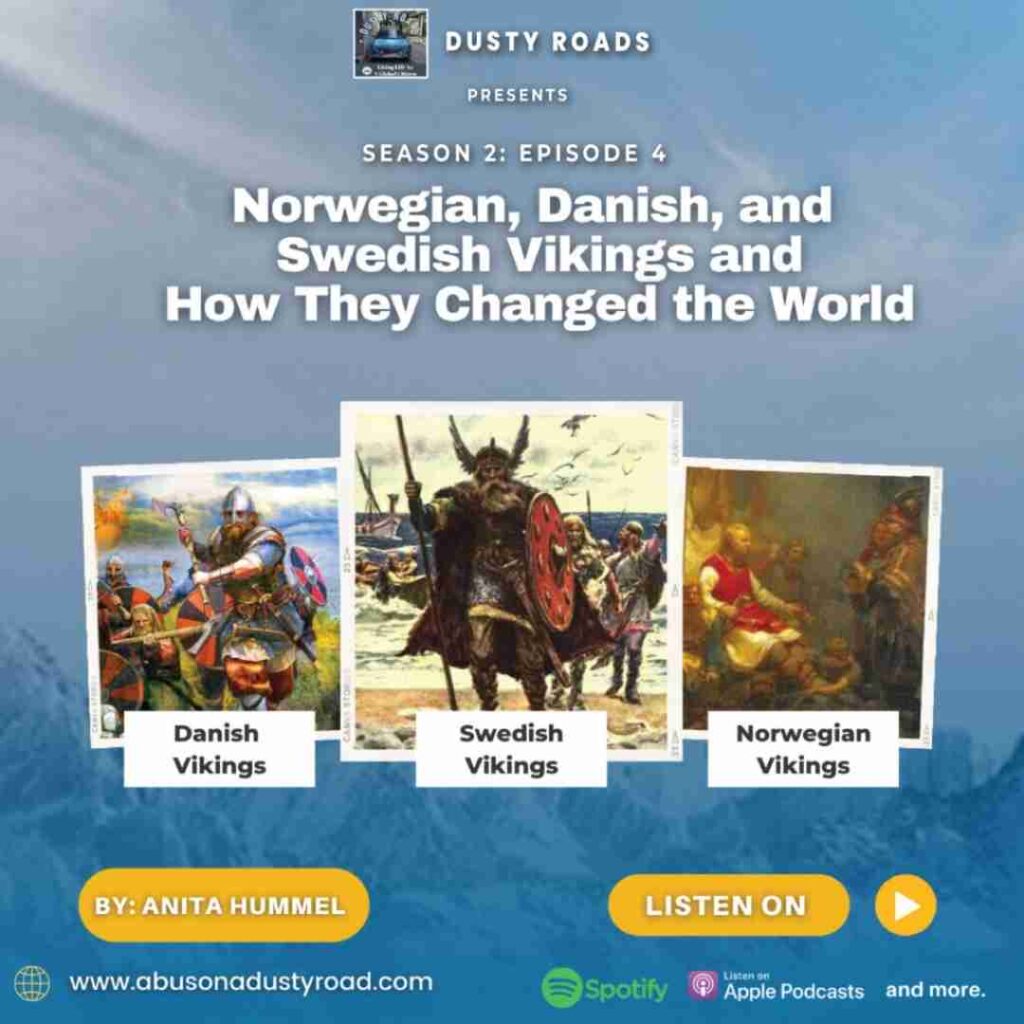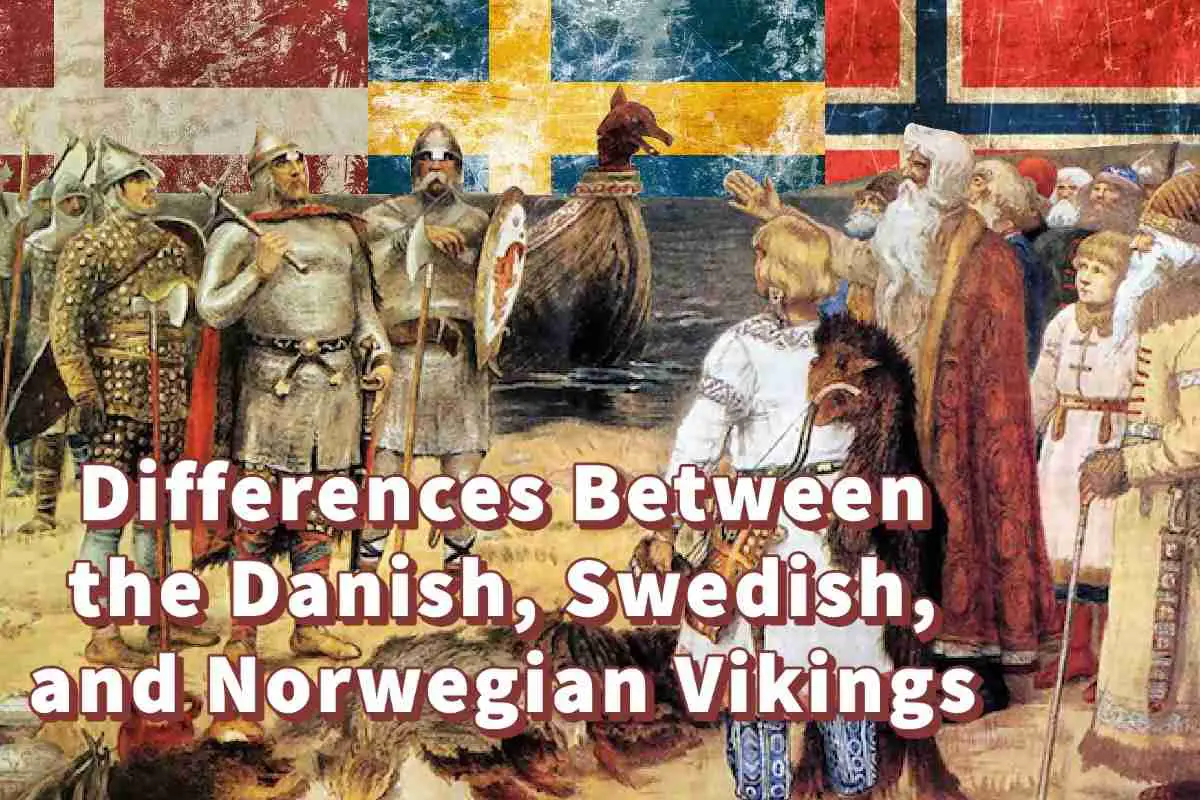Today when many people talk about the Vikings, they speak broadly about them being one group of people. The truth is that the Vikings in Denmark, Sweden, and Norway were not entirely homogeneous.
The Danish Vikings were the most political of the three groups of Vikings, as they had a noble family behind them and their expeditions. The Norwegians Vikings were the most violent and traveled the furthest. The Swedish Vikings went through Europe, not westward like the Danish and Norweigan Vikings.
Table of Contents
- Differences Between Danish, Swedish, and Norwegian Vikings
- Differences Between The Danish, Norwegian, and Swedish Vikings Explained
- Related Questions
Both the Danish and the Norwegian Vikings traveled westward. The Swedish Vikings were the Vikings who traveled eastward. The Swedes were also the last group of Vikings to convert to Christianity.
Differences Between Danish, Swedish, and Norwegian Vikings
When many people think of the Vikings, they think of the Vikings as one group of people who went off to violently explore the world. But this is not true; today, we know that these three groups of Vikings were not the same.
During the times of the Vikings, Scandinavia had no consistent forms of government or anything that we considered a nation-state.
Although the Vikings all spoke a similar language, there were some regional differences. Even today, Norwegian, Swedish, and Danish can have a lot of similar words but with different pronunciations or accents.
Even though all the Viking groups eventually did become Christian, the Danes became Christian first, then the Norwegians, and finally the Swedes. So even though they all became Christian, they did not become Christian simultaneously.
The Vikings also traveled in different directions. Many Swedish Vikings went east with the Danes, and the Norwegians went westward. The Danes also had their nobility behind them, so they were more of a political group.
When we talk about the Vikings and the violence, we have pictures of a strong man carrying an ax and going into battle. But it was the Norwegian Vikings that were the most violent out of the three groups of Vikings.
The Norwegian Vikings also had the best ships, navigators, and explorers. For this reason, they also were the Vikings that traveled the furthest.

Listen To Our Podcast About Norwegian Danish and Swedish Vikings and How They Changed The World below or by clicking here.
Differences Between The Danish, Norwegian, and Swedish Vikings Explained
The Vikings were one of the most dominant civilizations in Europe during the Middle Ages, conquering large parts of England and Scotland and establishing settlements from Scandinavia to North America. But did you know that there were three main branches of Vikings?
The Danish, Norwegian, and Swedish all had distinct cultures, appearances, locations of settlement, and more – so let’s take a closer look at each one! Come with us on an adventure deep into Viking history as we explore the differences between each group of Vikings.
The Danish Vikings – The Most Politically Organized Vikings
The Danish Vikings, also known as the Danes, were the most politically organized of the different types of Vikings. The Danish king played a more significant role in the Viking invasions.
It also meant that the days for the strongest of all of the other two Vikings and had more political clout than the Norwegian and Swedish Vikings.
The Danish Vikings were also the first of the three groups of Vikings to convert to Christianity. The Danish Vikings were almost entirely converted to Christianity by the ninth century.
The main focus of the Danish Vikings was to discover and pillage the west. Their focus was on France and England, and the Mediterranean area.
The Danish Vikings eventually helped form the country of Denmark.
The Norwegian Vikings – The Crazed Warriors Vikings
The Norwegian Vikings can best be described as crazed warriors. The scenes of crazy Vikings with their axes in combat are from the Norwegian Vikings.
Archaeological evidence shows that Norwegian Vikings were a powerful group of Vikings; what many think of Vikings today comes from the Norwegian Vikings and their axes and violent battles.
The Norwegians were also the best boat builders and sailors; these skills gave them the advantage of having some of the Vikings’ best boats and some of the best navigators out there.
The Norwegian Vikings were excellent explorers; they are known to have sailed to Iceland, Greenland, and even the Americas.
Unlike their Danish counterparts, they did not immediately embrace Christianity but remained pagan for a while.
The Swedish Vikings – Went Eastward To Discover New Lands
The Swedish Vikings were also known as the Varangians or Rus. Like their Danish and Norwegian counterparts who went westward to discover new lands, the Swedish Vikings went east, mainly along the Volga and Dnieper rivers.
The Swedish Vikings are also the last Vikings to convert to prove Christianity. They remained pagan for a long time and only converted to Christianity in the early part of the 12th century.
The Swedish Vikings were also very different from the Danes or the Norwegians. They were excellent explorers and traders and were not as violent as the Danish or Norwegian Vikings.
From archaeological discoveries, it seems that one of their primary focuses was to trade. They established trade routes into the middle east and the Black Sea area.
The Swedish Vikings were known to terrorize groups along the Baltic, but their focus was more on trade and not just pilferage.
Even though many people see the Vikings as one group of people, the Danish, Norweigan, and Swedish Vikings were three very distinct groups of Viking explorers.
At A Bus On A Dusty Road, we talk about everything about travel, life, and ex-pat living. We are all about “Living Life As A Global Citizen.” We explore social, cultural, and economic issues and travel.
We would love to have you be part of our community. Sign up for our newsletter to keep up-to-date by clicking here. If you have any questions, you can contact me, Anita, by clicking here.
Listen to our Podcast called Dusty Roads. You can find it on all major podcast platforms. Try out listening to one of our podcasts by clicking here.
Subscribe to our A Bus On A Dusty Road YouTube Channel filled with great videos and information by clicking here.
Related Questions
Why is Filipino Spelled with an ‘F’ when the Philippines is Spelled with a ‘Ph’?
The word Filipino is spelled with an “F” instead of a “Ph” as it has to go back to when the Spanish came to the Philippines. When the Spanish arrived on the Philippine Island, they named this group or archipelago islands Islas Filipinas. The term Filipino is leftover from the time when the Spanish called the island Filipinas.
You can learn more by reading Why is Filipino Spelled with an ‘F’ when the Philippines is spelled with a ‘Ph’? by clicking here.
10 Myths Debunked About The Philippines
Some of the myths about the Philippines are that doctors and nurses can have tattoos, if it’s okay to drink the tap water and whether or not you are allowed to wear shorts in the Philippines. Also, there are some myths that people think everyone in the Philippines is skinny, has no diabetes, and vegetables are one of the main staples of their diet.
You can learn more by reading 10 Myths Debunked About The Philippines by clicking here.


